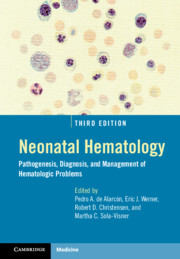Book contents
- Neonatal Hematology
- Neonatal Hematology
- Copyright page
- Contents
- Foreword
- Preface
- Contributors
- Section I Developmental Hematology
- Chapter 1 A Historical Review
- Chapter 2 Hematopoiesis
- Chapter 3 The Development of the Human Immune System
- Section II Bone Marrow Failure and Immune Disorders
- Section III Erythrocyte Disorders
- Section IV Platelet Disorders
- Section V Leucocyte Disorders
- Section VI Hemostatic Disorders
- Section VII Neonatal Transfusion Medicine
- Section VIII Neonatal Oncology
- Section IX Miscellaneous
- Index
- Plate Section (PDF Only)
- References
Chapter 3 - The Development of the Human Immune System
from Section I - Developmental Hematology
Published online by Cambridge University Press: 30 January 2021
- Neonatal Hematology
- Neonatal Hematology
- Copyright page
- Contents
- Foreword
- Preface
- Contributors
- Section I Developmental Hematology
- Chapter 1 A Historical Review
- Chapter 2 Hematopoiesis
- Chapter 3 The Development of the Human Immune System
- Section II Bone Marrow Failure and Immune Disorders
- Section III Erythrocyte Disorders
- Section IV Platelet Disorders
- Section V Leucocyte Disorders
- Section VI Hemostatic Disorders
- Section VII Neonatal Transfusion Medicine
- Section VIII Neonatal Oncology
- Section IX Miscellaneous
- Index
- Plate Section (PDF Only)
- References
Summary
Neonates frequently suffer from life threatening infections. Immaturity of the immune system increases the vulnerability to infection, and the preterm and term neonatal immune system has specific deficiencies relative to that of an older child or adult [1, 2]. During pregnancy, the physical barrier of the placenta and the maternal immune system protect the developing human fetus from infection. However, maternal infections such as rubella, almost eradicated in developed nations through vaccination [3], or the zika virus, an emerging pathogen [4, 5], can ravage the developing embryo and fetus, leading to life-long disabilities. Furthermore, immaturity of natural barrier systems such as skin, bronchial epithelium and the lining of the gastrointestinal tract compound the weaknesses of the immune system of the premature infant [6, 7]. The importance of interactions between the developing immune system, epithelial barriers, and the microbiome to protect the preterm neonate from infection and promote health is increasingly recognized [8, 9]. Ethical and political concerns limit our ability to study the embryological development of the human immune system to the same depth [10, 11].
- Type
- Chapter
- Information
- Neonatal HematologyPathogenesis, Diagnosis, and Management of Hematologic Problems, pp. 25 - 42Publisher: Cambridge University PressPrint publication year: 2021
References
- 2
- Cited by



